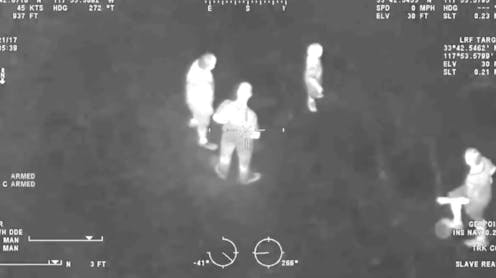
In his book War and Cinema, cultural theorist Paul Virilio noted that modern warfare depends on the “logistics of perception.” According to him, a new arena of conflict has emerged with the development of sophisticated imaging technology. Like better weaponry, the side with better cameras often gains superiority.
Virilio said new imaging technology “makes darkness transparent and gives to military contestants an image of what the night is no longer able to conceal.” With thermal and night-vision cameras, any moving presence glowing in darkness becomes susceptible to gunfire by combat helicopters hovering above conflict zones.
Éléonore Weber’s 2020 documentary, There Will Be No More Night, reflects on this phenomenon. It uses leaked military footage from U.S. and French helicopters during war missions in Iraq, Syria and Afghanistan.
The unnerving sequence of night-vision footage shows airstrikes on civilians suspected of being militants by pilots with shaky conviction. The blurry, grainy images accompany radio-transmitted exchanges between aircraft and machine gun operators, confessions of a pilot who suffers from chronic hallucinations and a scripted monologue.
Weber creatively uses forensic sources to contemplate the technology of modern warfare, where military-grade surveillance and imaging almost serve as a proxy for guns.
As we approach the 20th anniversary of the U.S.-led invasion of Iraq, it is important to reflect on the use of war footage in media and the ethical questions around the use of footage depicting human death.
Highlighting human rights abuses
There Will Be No More Night underscores the fallacy that advanced imaging provides accuracy and error-proof precision to modern war. The documentary shows how sophisticated war machines are driven by the personal idiosyncrasies of drone operators who launch deadly missiles using systems that resemble video games.
While Virilio traced aesthetic similarities between the videography of war and cinema, Weber’s documentary film uses war footage to highlight the camera’s impairing role in contemporary conflicts.
The surveillance recordings document the offhanded killing of the people targeted. Weber includes the infamous Wikileaks footage showing the airstrike that killed Iraqi Reuters photographer Saeed Chmagh and his colleagues in 2007. According to the pilots, Chmagh’s camera tripod resembled an RPG grenade launcher in the grainy footage.
In other instances, farmers carrying ploughs get mistaken for militants. Another harrowing scene depicts a person showered with bullets because he appeared unusually calm when cornered by a helicopter pilot.
Advanced imaging technologies in warfare seemingly operate on a peculiar logic, where framing inevitably leads to the manufacturing and annihilation of suspects. According to media theorist Harun Farocki, they generate “operational images” that do not merely represent but execute the functions of operations they belong to.
Weber’s creative use of forensic materials records a series of war violations. Scholars Patrick Brian Smith and Ryan Watson use the term “mediated forensics” to describe the use of new media technologies and practices in human rights discourse.
Research-activist groups like Forensic Architecture, SITU Research and WITNESS Media Lab perform forensic analysis of raw media evidence to highlight human rights issues. They do so using techniques and technologies such as photogrammetry, geolocation mapping, 3D-imaging and pattern analysis to infer unseen viewpoints from limited visual evidence.
A question of ethics
There Will Be No More Night sidesteps such principled forensic analysis. Instead of dissecting raw media evidence and disclosing new perspectives around specific events, it simply reproduces images of brutal killings for a generalized, self-absorbed reflection on modern warfare.
Consequently, the film becomes emotionally distressing and ethically dubious. One cannot discard the uneasy concerns of witnessing 125 minutes of footage depicting brutal massacres from the cockpit.
The documentary also humanizes one pilot, Pierre V., as he reflects on his nightmares after controlling infrared and thermal cameras for several months. But nothing is heard from the other side; those who live under the perpetual threat of the weapons and cameras, and need to devise inventive ways to escape their thermal imagery.
A related problem surfaces in the documentary project Heat Maps by Irish photographer Richard Mosse. He uses thermal video cameras to construct composite images of refugee camps in and around the Mediterranean.
But the visually arresting photographs further expose the subjects and deny them self-representation. Mosse also enjoys freedom of movement and has control over the photographed images of the subjects — rights the subjects themselves do not have.
Despite its acute critique of modern warfare, There Will Be No More Night could have devised measures to work around the reproduction of visuals of death. Its distanced approach, driven by a voice-over commentary, fails to account for divergent perspectives.
What appears jarringly absent in the film are the voices of those people who are continually mapped by the imaging technologies of modern warfare and the social and psychological effects the technologies have on them.
Santasil Mallik does not work for, consult, own shares in or receive funding from any company or organization that would benefit from this article, and has disclosed no relevant affiliations beyond their academic appointment.
This article was originally published on The Conversation. Read the original article.







